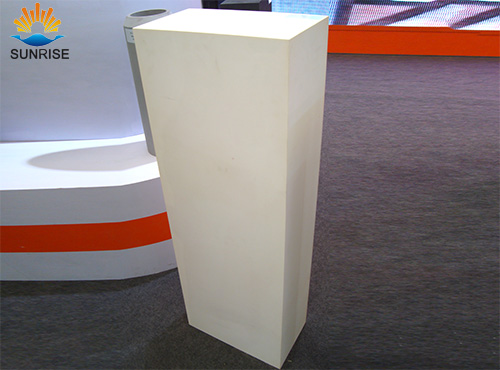Tabular Corundum Brick vs. Fused Corundum Brick
Date:2016-07-14 18:47 From:Zhengzhou Sunrise Refractory Author:admin
High purity corundum bricks have excellent corrosion resistance, wear resistance, good high temperature strength, high softening temperature under load and creep resistance. They are widely used in the linings of the residual oil gasifier, coal gasifier, paper pulp waste gasifier and other industrial furnaces.

Compared to tabular alumina, fused alumina has high content of SiO2, about 0.10%, and unstable sodium content. Besides, the porosity of fused alumina can reach up to 8.8% and most pores are present in the form of single large pores or pores gathering together, while most pores in tabular alumina are small closed pores and distributed in the particles of tabular alumina.
Fused alumina and tabular alumina are the main raw materials for manufacturing corundum refractories. They have a low content of SiO2, high bulk density and good thermal properties. Those advantages make them be able to resist the thermal, chemical and structural damage in the furnace.
The manufacturing process of fused alumina and tabular alumina is different. So are their properties. Tabular alumina is widely used to produce high performance refractories used in steel making industry such as sliding nozzle, Al2O3-MgO-C brick, castable and prefabricated parts. Bricks used in non-steel industries are made of fused alumina. Fused alumina has a bulk density and good corrosion resistance, so it can increase the density of products and improve the overall performance.
High purity corundum bricks completely with tabular alumina as the aggregate material are fired at 1750℃. They have the lowest porosity (13.8%) and the highest bulk density (3.26g/cm3) among corundum bricks. And the higher the content of tabular alumina is, the lower the apparent porosity is, the higher the bulk density is. Bricks completely with fused alumina as the aggregate material have the highest porosity and the lowest bulk density.
Given the firing shrinkage, tabular corundum bricks have better thermodynamic activity and are easy to obtain dense products. Besides, they can be fully sintered at a relatively low temperature. This can help save energy. Their cold crushing strength is up to 147MPa, twice that of fused corundum bricks. They also have higher flexural strength at room temperature and high temperature. Fused corundum bricks have lower strength, since there are micro-cracks between aggregate materials and the matrix, which is not conducive to enhancing strength.
The abrasion test shows that, pure tabular corundum bricks have the best abrasion resistance and the material loss is half of that of fused corundum bricks. This is attributed to their good ceramic bonding and the high toughness. However, the composite bricks with tabular alumina and fused alumina do not obtain good abrasion resistance.
Both tabular and fused corundum bricks have better creep resistance than the composite bricks. So, composite aggregate materials cannot improve the creep resistance. Since tabular alumina and fused alumina have different expansion, the composite bricks have slight larger deformation under load.
Among corundum bricks, tabular corundum bricks have the smallest depth of erosion and penetration. With the increasing of the content of tabular alumina, the corrosion resistance of composite bricks is increased.
